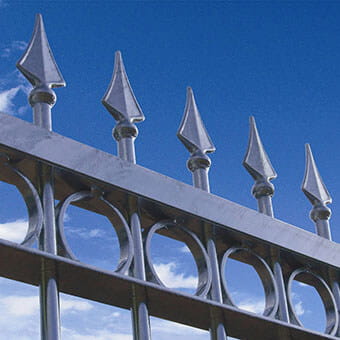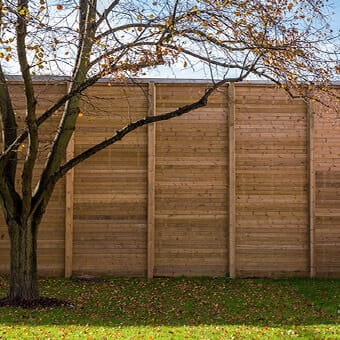Our other sites:
Whether you're an architect, specifier, part of a procurement team, or involved in planning security measures, getting fence heights right is crucial. From domestic gardens to high security sites like prisons and data centres, different applications come with specific requirements and risks. Based on our experience working across multiple sectors and official guidance provided for some applications, this guide explores the recommended fence heights for various applications. While there are regulations in place, much of what works best comes down to security, safety, and practicality. Here, we’ll share our insights into what typically works well in different settings and the risks to consider.
Domestic Properties
Garden Fencing
For residential properties, fencing is about balancing privacy, security, and aesthetics. A fence that’s too low might not deter intruders, while an overly high one could make a property feel closed off. The Building Regulations 2010 and local planning authorities provide clear guidance:
Rear and side garden fences can be up to 2 metres (6.6ft), providing good privacy and security without being overbearing. For front gardens or fences facing roads, a lower height of 1 metre (3.3ft) is the maximum without planning permission. This maintains sightlines while still offering some boundary definition.

If you’re considering something taller, it’s always best to check with the local planning authority, as anything exceeding these heights will usually require permission. Conservation areas and listed buildings often have stricter rules, so early research is essential. All the latest specifications can be found on the UK planning Portal website.
Domestic fences offer many configuration options. For example, adding a lattice trellis topper to solid panels can enhance both style and function. This allows a 2m fence to provide privacy and security while letting natural light pass through, preventing it from feeling too imposing.

School fence heights
Schools require fencing that keeps students safe while maintaining a welcoming environment. Combining Government guidelines and our own experience, school perimeter fencing is most effective when it’s between 2 and 2.4 metres (6-8ft). This provides a secure boundary without feeling like a prison. Bear in mind that previous Government guidance before the update in 2024, stated 1.8m as a minimum height for school fencing. For internal boundaries within a school (such as separating playgrounds or sports areas), fences around 1.2 to 1.5 metres (4-5ft) usually work well. Fences need to be high enough to prevent unauthorised entry or truancy, but not so imposing that they create an intimidating atmosphere.

Playground fencing height
Playground fencing is all about striking the right balance between safety and visibility. While short fences do not stop older children climbing, maintaining sightlines for supervision is more important here. The design and construction of the fence should be what stops any damage. In addition, the fence should be BS EN 1176 compliant and RoSPA approved. Generally, a minimum of 1 metre (3.3ft) is recommended to prevent toddlers from wandering out. 1.2m high fencing is also commonly used. For adventure playgrounds, fencing over 1.8m is preferred, but again, maintaining that visibility by using mesh fencing.

Sports fencing
Fencing heights for sports vary depending on the sport and governing body regulations. Some common heights and types of sports fencing include:
Transport Infrastructure
Roads
Roadside fencing serves different purposes, from preventing pedestrian access to reducing noise pollution. Pedestrian guard rails are usually between 1 and 2m tall. With acoustic barriers, the sky is the limit, depending on location and local regulations and obviously the planning outcome. Roadside acoustic barriers must be UKCA marked as a system. Remember that anything over 1 metre tall next to a road requires planning permission.
Railways
Fencing around railways is critical for public safety. Standard trackside fencing is generally 1.8 to 2 metres (6-6ft), increasing to 2.4 metres (8ft) in high risk areas such as near schools. Train stations often require higher fencing and anti-climb features to deter fare dodgers.
Prison fencing heights
Prison fencing is among the most specialised. Perimeter fences are typically 5 to 6 metres high (16-20ft) and often feature razor wire, anti-climb coatings, and electronic monitoring. Obvious risks include prisoners escaping via tunnelling or climbing, and external threats like contraband being thrown over or passed through the fence.
Fencing height for data centres
For data centres, fencing must balance security with discretion. A height of 2.4 to 3.6 metres (8-12ft) is common, often incorporating anti-climb measures and controlled access points. Above all, physical security should complement digital protection to align with cyber security.
Water Treatment Plants
Water treatment plants require robust security, with fencing typically standing at 2.4 to 3 metres (8-10ft). Anti-climb fence designs are recommended.
Security Toppings
Adding security toppings such as barbed wire or anti-climb spikes can significantly enhance protection, but they must be positioned correctly. As a general rule, security toppings should not be installed below 2 metres (6.6ft) in public areas. When used, they typically add an extra 0.6 to 1 metre (2-3ft) to the fence’s overall height and should always be clearly signposted to avoid liability issues.
General Considerations Under Building Regulations
While there are no universal laws governing all fence heights, The Building Regulations 2010 set out some important considerations:
Specifying the right fence height requires balancing security, functionality, and aesthetics. While regulations provide a framework, practical experience is key to determining what works best in each sector. By considering the specific risks and needs of different environments, you can specify fencing solutions that offer security without compromise.
If you have a specific application for which you are trying to work out the fence height, contact our team for advice.
Related products
Jacksons Security has a range of products relating to this article, all complete with our 25 year service life guarantee. If you cannot find the item you are looking for, please do not hesitate to call our friendly sales team.
Related Content
Top







